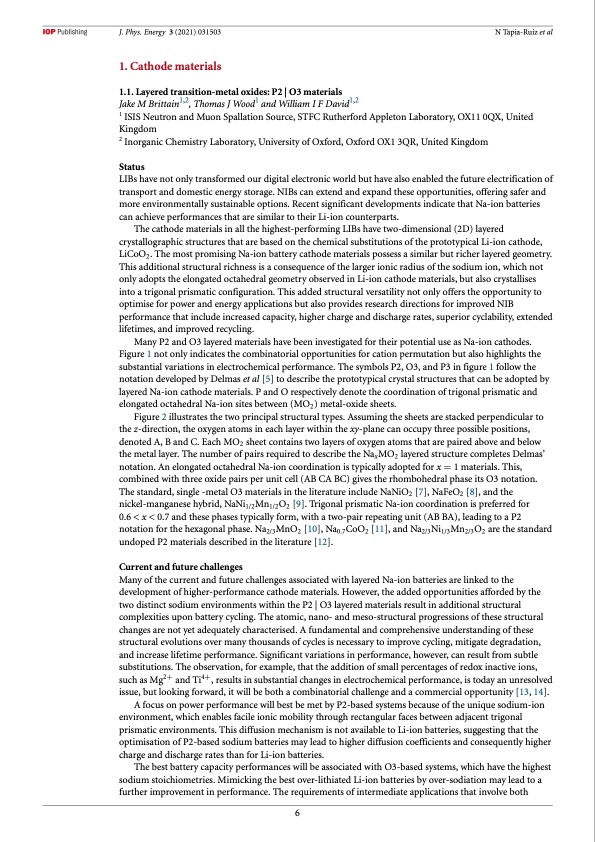
PDF Publication Title:
Text from PDF Page: 007
J. Phys. Energy 3 (2021) 031503 N Tapia-Ruiz et al 1. Cathode materials 1.1. Layered transition-metal oxides: P2 | O3 materials Jake M Brittain1,2, Thomas J Wood1 and William I F David1,2 1 ISIS Neutron and Muon Spallation Source, STFC Rutherford Appleton Laboratory, OX11 0QX, United Kingdom 2 Inorganic Chemistry Laboratory, University of Oxford, Oxford OX1 3QR, United Kingdom Status LIBs have not only transformed our digital electronic world but have also enabled the future electrification of transport and domestic energy storage. NIBs can extend and expand these opportunities, offering safer and more environmentally sustainable options. Recent significant developments indicate that Na-ion batteries can achieve performances that are similar to their Li-ion counterparts. The cathode materials in all the highest-performing LIBs have two-dimensional (2D) layered crystallographic structures that are based on the chemical substitutions of the prototypical Li-ion cathode, LiCoO2. The most promising Na-ion battery cathode materials possess a similar but richer layered geometry. This additional structural richness is a consequence of the larger ionic radius of the sodium ion, which not only adopts the elongated octahedral geometry observed in Li-ion cathode materials, but also crystallises into a trigonal prismatic configuration. This added structural versatility not only offers the opportunity to optimise for power and energy applications but also provides research directions for improved NIB performance that include increased capacity, higher charge and discharge rates, superior cyclability, extended lifetimes, and improved recycling. Many P2 and O3 layered materials have been investigated for their potential use as Na-ion cathodes. Figure 1 not only indicates the combinatorial opportunities for cation permutation but also highlights the substantial variations in electrochemical performance. The symbols P2, O3, and P3 in figure 1 follow the notation developed by Delmas et al [5] to describe the prototypical crystal structures that can be adopted by layered Na-ion cathode materials. P and O respectively denote the coordination of trigonal prismatic and elongated octahedral Na-ion sites between (MO2) metal-oxide sheets. Figure 2 illustrates the two principal structural types. Assuming the sheets are stacked perpendicular to the z-direction, the oxygen atoms in each layer within the xy-plane can occupy three possible positions, denoted A, B and C. Each MO2 sheet contains two layers of oxygen atoms that are paired above and below the metal layer. The number of pairs required to describe the NaxMO2 layered structure completes Delmas’ notation. An elongated octahedral Na-ion coordination is typically adopted for x = 1 materials. This, combined with three oxide pairs per unit cell (AB CA BC) gives the rhombohedral phase its O3 notation. The standard, single -metal O3 materials in the literature include NaNiO2 [7], NaFeO2 [8], and the nickel-manganese hybrid, NaNi1/2Mn1/2O2 [9]. Trigonal prismatic Na-ion coordination is preferred for 0.6 < x < 0.7 and these phases typically form, with a two-pair repeating unit (AB BA), leading to a P2 notation for the hexagonal phase. Na2/3MnO2 [10], Na0.7CoO2 [11], and Na2/3Ni1/3Mn2/3O2 are the standard undoped P2 materials described in the literature [12]. Current and future challenges Many of the current and future challenges associated with layered Na-ion batteries are linked to the development of higher-performance cathode materials. However, the added opportunities afforded by the two distinct sodium environments within the P2 | O3 layered materials result in additional structural complexities upon battery cycling. The atomic, nano- and meso-structural progressions of these structural changes are not yet adequately characterised. A fundamental and comprehensive understanding of these structural evolutions over many thousands of cycles is necessary to improve cycling, mitigate degradation, and increase lifetime performance. Significant variations in performance, however, can result from subtle substitutions. The observation, for example, that the addition of small percentages of redox inactive ions, such as Mg2+ and Ti4+, results in substantial changes in electrochemical performance, is today an unresolved issue, but looking forward, it will be both a combinatorial challenge and a commercial opportunity [13, 14]. A focus on power performance will best be met by P2-based systems because of the unique sodium-ion environment, which enables facile ionic mobility through rectangular faces between adjacent trigonal prismatic environments. This diffusion mechanism is not available to Li-ion batteries, suggesting that the optimisation of P2-based sodium batteries may lead to higher diffusion coefficients and consequently higher charge and discharge rates than for Li-ion batteries. The best battery capacity performances will be associated with O3-based systems, which have the highest sodium stoichiometries. Mimicking the best over-lithiated Li-ion batteries by over-sodiation may lead to a further improvement in performance. The requirements of intermediate applications that involve both 6PDF Image | 2021 roadmap for sodium-ion batteries

PDF Search Title:
2021 roadmap for sodium-ion batteriesOriginal File Name Searched:
roadmap-sodium-ion-batteries_031503.pdfDIY PDF Search: Google It | Yahoo | Bing
Salgenx Redox Flow Battery Technology: Salt water flow battery technology with low cost and great energy density that can be used for power storage and thermal storage. Let us de-risk your production using our license. Our aqueous flow battery is less cost than Tesla Megapack and available faster. Redox flow battery. No membrane needed like with Vanadium, or Bromine. Salgenx flow battery
| CONTACT TEL: 608-238-6001 Email: greg@salgenx.com | RSS | AMP |